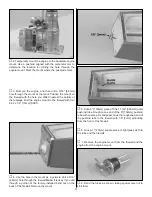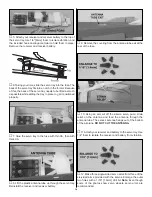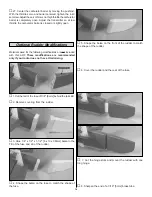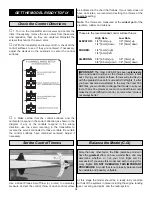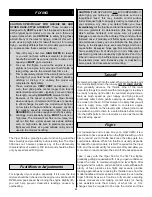
The Viper 500 is a great-flying sport and racing model that
flies smoothly and predictably, but incredibly fast. The Viper
500 does not, however, possess any of the self-recovery
characteristics of a primary R/C trainer and should be flown
only by experienced R/C pilots.
For longevity of your engine, especially if it is new, the fuel
mixture should be richened so the engine runs at about 400
RPM below peak speed. By running the engine slightly rich,
you will help prevent dead-stick landings caused by
overheating.
Remember to takeoff into the wind. When you’re ready, point
the model straight down the runway,
GO TO HIGH RATES,
then gradually advance the throttle. One of the most
important things to remember with a tail dragger is to always
be ready to apply right rudder to counteract engine torque.
Gain as much speed as your runway and flying site will
practically allow before gently applying up elevator, lifting
the model into the air. At this moment it is likely that you will
need to apply more right rudder to counteract engine
torque. Be smooth on the elevator stick, allowing the model
to establish a gentle climb to a safe altitude before turning
into the traffic pattern. Go to low rates as soon as the model
has picked up speed.
For reassurance and to keep an eye on other traffic, it is a
good idea to have an assistant on the flight line with you. Tell
him to remind you to throttle back once the plane gets to a
comfortable altitude. While full throttle is usually desirable
for takeoff on sport models, it is NOT required for the Viper
500, and the model will fly far more smoothly and allow you
more time to react and learn the aircraft at reduced speeds.
Take it easy with the Viper 500 for the first few flights,
gradually getting acquainted with it as you gain confidence.
Adjust the trims to maintain straight and level flight. After
flying around for a while, and while still at a safe altitude with
plenty of fuel, practice slow flight and execute practice
landing approaches by reducing the throttle to see how the
model handles at slower speeds. Add power to see how the
Viper 500 climbs as well. Continue to fly around, executing
various maneuvers and making mental notes (or having
your assistant write them down) of what trim or C.G.
changes may be required to fine tune the model so it flies
Flight
Takeoff
CAUTION (THIS APPLIES TO ALL R/C AIRPLANES): If,
while flying, you notice any unusual sounds, such as a
low-pitched “buzz,” this may indicate control surface
flutter. Because flutter can quickly destroy components of
your airplane, any time you detect flutter you must
immediately cut the throttle and land the airplane! Check
all servo grommets for deterioration (this may indicate
which surface fluttered), and make sure all pushrod
linkages are secure and free of play. If the control surface
fluttered once, it probably will flutter again under similar
circumstances unless you can eliminate the free-play or
flexing in the linkages. Here are some things which can
cause flutter: Excessive hinge gap; Not mounting control
horns solidly; Poor fit of clevis pin in horn; Side-play of
pushrod in guide tube caused by tight bends; Poor fit of
Z-bend in servo arm; Insufficient glue used when gluing in
the elevator joiner wire; Excessive
play or backlash in
servo gears; and Insecure servo mounting.
Fuel Mixture Adjustments
CAUTION SPECIFICALLY FOR QUICKIE 500 AND
OTHER RACE-STYLE AIRCRAFT: These models are
designed to fly VERY quickly. Their top speed is twice that
of the typical sport model, or more. As such, there are
several rules which are CRITICAL to safely flying these
aircraft. Many of the rules for flying a model of this sort –
such as using high rates for take-off and not for normal
flying – are likely different from most models you are used
to, so please take these cautions seriously.
1.
Take-off is very short. Use HIGH RATES for takeoff
or you will not have sufficient elevator to properly
handle the aircraft. As soon as it starts to come up to
speed you MUST go to low rates.
2.
For your first flights, be sure the engine is tuned
slightly rich and plan to fly around at half throttle or
less, getting used to the model’s feel, trims, etc.
3.
Trim is absolutely critical. If the aircraft cannot cover
the length of your field hands off without banking,
climbing or diving, it is unlikely the model will
complete the flight safely.
4.
These models are VERY, VERY aerodynamic. As
such, their glide paths are far longer than that of
similar sized sport models – typically 2 or even 3 times
the length, requiring HIGH RATE elevator to flair.
5.
Because of the speed at which the Viper travels
when wide open, minimal control throws are needed
to effect change. As such, the model must be flown
on low rates for those conditions. However, any time
the model’s speed is decreased, high rates are
REQUIRED to provide enough control to fly safely.
6.
Landings, and especially flaring, MUST be done on
high rates. The model will not flair on low rates, and
will not flair from a slow speed nose-down attitude
even on high rates. Be sure to practice low speed
flight several times at a good altitude until you are
used to the model’s handling.
FLYING
22




